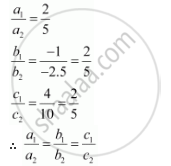Advertisements
Advertisements
Question
The planes: 2x − y + 4z = 5 and 5x − 2.5y + 10z = 6 are
(A) Perpendicular
(B) Parallel
(C) intersect y-axis
(C) passes through `(0,0,5/4)`
Solution
The equations of the planes are
2x − y + 4z = 5 … (1)
5x − 2.5y + 10z = 6 … (2)
It can be seen that,

Therefore, the given planes are parallel.
Hence, the correct answer is B.
APPEARS IN
RELATED QUESTIONS
In following cases, determine the direction cosines of the normal to the plane and the distance from the origin.
z = 2
If the coordinates of the points A, B, C, D be (1, 2, 3), (4, 5, 7), (−4, 3, −6) and (2, 9, 2) respectively, then find the angle between the lines AB and CD.
Find the coordinates of the point where the line through (5, 1, 6) and (3, 4, 1) crosses the YZ-plane
Find the coordinates of the point where the line through (5, 1, 6) and (3, 4, 1) crosses the ZX − plane.
Find the coordinates of the point where the line through (3, −4, −5) and (2, − 3, 1) crosses the plane 2x + y + z = 7).
Find the coordinates of the point where the line through the points (3, - 4, - 5) and (2, - 3, 1), crosses the plane determined by the points (1, 2, 3), (4, 2,- 3) and (0, 4, 3)
Find the equation of the plane passing through the point (2, 3, 1), given that the direction ratios of the normal to the plane are proportional to 5, 3, 2.
If the axes are rectangular and P is the point (2, 3, −1), find the equation of the plane through P at right angles to OP.
Find the intercepts made on the coordinate axes by the plane 2x + y − 2z = 3 and also find the direction cosines of the normal to the plane.
Reduce the equation 2x − 3y − 6z = 14 to the normal form and, hence, find the length of the perpendicular from the origin to the plane. Also, find the direction cosines of the normal to the plane.
Reduce the equation \[\vec{r} \cdot \left( \hat{i} - 2 \hat{j} + 2 \hat{k} \right) + 6 = 0\] to normal form and, hence, find the length of the perpendicular from the origin to the plane.
Find a unit normal vector to the plane x + 2y + 3z − 6 = 0.
Find the distance of the plane 2x − 3y + 4z − 6 = 0 from the origin.
Prove that the line of section of the planes 5x + 2y − 4z + 2 = 0 and 2x + 8y + 2z − 1 = 0 is parallel to the plane 4x − 2y − 5z − 2 = 0.
Find the value of λ such that the line \[\frac{x - 2}{6} = \frac{y - 1}{\lambda} = \frac{z + 5}{- 4}\] is perpendicular to the plane 3x − y − 2z = 7.
Find the equation of the plane passing through the points (−1, 2, 0), (2, 2, −1) and parallel to the line \[\frac{x - 1}{1} = \frac{2y + 1}{2} = \frac{z + 1}{- 1}\]
Find the vector equation of the plane passing through the points (3, 4, 2) and (7, 0, 6) and perpendicular to the plane 2x − 5y − 15 = 0. Also, show that the plane thus obtained contains the line \[\vec{r} = \hat{i} + 3 \hat{j} - 2 \hat{k} + \lambda\left( \hat{i} - \hat{j} + \hat{k} \right) .\]
Write the plane \[\vec{r} \cdot \left( 2 \hat{i} + 3 \hat{j} - 6 \hat{k} \right) = 14\] in normal form.
Write a vector normal to the plane \[\vec{r} = l \vec{b} + m \vec{c} .\]
Write the value of k for which the line \[\frac{x - 1}{2} = \frac{y - 1}{3} = \frac{z - 1}{k}\] is perpendicular to the normal to the plane \[\vec{r} \cdot \left( 2 \hat{i} + 3 \hat{j} + 4 \hat{k} \right) = 4 .\]
Write the vector equation of the line passing through the point (1, −2, −3) and normal to the plane \[\vec{r} \cdot \left( 2 \hat{i} + \hat{j} + 2 \hat{k} \right) = 5 .\]
Find the vector equation of a plane which is at a distance of 5 units from the origin and its normal vector is \[2 \hat{i} - 3 \hat{j} + 6 \hat{k} \] .
The equation of the plane containing the two lines
The equation of the plane \[\vec{r} = \hat{i} - \hat{j} + \lambda\left( \hat{i} + \hat{j} + \hat{k} \right) + \mu\left( \hat{i} - 2 \hat{j} + 3 \hat{k} \right)\] in scalar product form is
In the following cases find the c9ordinates of foot of perpendicular from the origin `2x + 3y + 4z - 12` = 0
